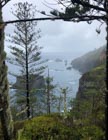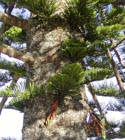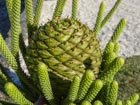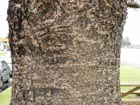
Trees in habitat on Norfolk Island [Scott Cumberland, 2020.03.18, Facebook post].

Forest on Norfolk Island [Scott Cumberland, 2020.03.18, Facebook post].

A very large tree in Auckland, New Zealand [C.J. Earle, 2003.03.12].

Foliage from a tree in Cornwall Park, Auckland, New Zealand, showing the variations in foliage from different parts of the crown; thus the epithet, heterophylla [C.J. Earle, 2003.03.12].

Epicormic foliage on an ornamental at Mairangi Bay Beach, New Zealand [C.J. Earle, 2003.03.12].

Newly ripe cone on an ornamental at Mairangi Bay Beach, New Zealand [C.J. Earle, 2003.03.12].

Pollen cones on a tree in the Dominican Republic [Dan Skean, 1992].

Pollen cones, each about 8 cm long, from a tree in the Huntington Botanical Gardens, California [C.J. Earle, 2001.03].

Bark on a 100 cm diameter ornamental tree in New Zealand [C.J. Earle, 2003.03.02].

Conservation Status

Araucaria heterophylla
(Salisb.) Franco (1952)
Common names
Norfolk Island pine.
Taxonomic notes
Syn: Abies columbaria Desf. 1815; Eutassa heterophylla Salis. 1807.
Description
Monoecious evergreen trees to 70 m tall and 60 cm dbh, with a conical crown. Bark gray-brown, exfoliating in fine scales. Branches in a flat horizontal plane, sometimes pendent, twigs in whorls of 4-7. Foliage dimorphic. Juvenile leaves awl-shaped, incurved, green, needle-like, to 12 mm long. Adult leaves scale-like, 4-5 mm long, incurved, densely arranged, bright dark green; on fertile branchlets overlapping, broadly ovate, spine-tipped, 6 × 4-6 mm. Pollen cones in clusters, elongated, 4 cm long, yellowish-brown or reddish; microsporophylls acute, margins ciliate, denticulate. Seed cones broader than long, 12-15 cm long, with triangular scales and a long incurved bract. Seeds 25-30 × 12 mm, with broad wings. Cotyledons 4, epigeal (Silba 1986). See García Esteban et al. (2004) for a detailed characterization of the wood anatomy.
Distribution and Ecology
Endemic to lowland areas of Norfolk Island, a small island (about 10 square kilometers) about 1500 km east of Australia (Silba 1986). You can also create a highly detailed map, and access specimen data, using the "search" function at the Australia Virtual Herbarium. The species is also a popular ornamental in Australia, New Zealand, Hawaii, California, and other places. Hardy to Zone 9 (cold hardiness limit between -6.6°C and -1.1°C) (Bannister and Neuner 2001).
The IUCN reports that this species is facing a high risk of extinction in the wild due to a limited and severely fragmented distribution, coupled with ongoing decline in extent and quality of habitat.
Remarkable Specimens
Trees as tall as 57 m have been recorded in the past, and this photograph, taken ca. 1900-1906, shows a tree 37 feet in girth at 5 feet off the ground, which works out to at least 359 cm dbh (thanks to Matt Smillie for finding this photo, 2016.05.30). One of the largest remaining trees on Norfolk Island, the Hollow Pine, can be seen in the National Park (Norfolk Island National Park 2007). This trees was measured in 2012 as 269 cm dbh and 43.0 m tall, 170 years old, planted (National Register of Big Trees 2012). The largest remaining tree on the island is 245 cm dbh, 51.93 m tall, measured in 2019, on private land on Norfolk Island; it seems to have naturally regenerated, though the site is now agricultural (National Register of Big Trees 2020). Comparably large trees now occur in mainland Australia, including a 220 cm dbh specimen 140 years old (measured 2011) in Gerringong, NSW; and a tree 43.0 m tall (in 2010) at Raymond Terrace, NSW (National Register of Big Trees 2012).
The largest diameter and the tallest trees are now ornamental specimens in New Zealand. The Grange Tree in Warkworth, planted in the 1850's, is 34.6 m tall and 317.6 cm dbh with a crown spread of 23.6 m (Robert Van Pelt email, 2009.04.14). A tree 52.1 m tall and 193 cm dbh grows at the Diocesan School for Girls in Auckland (Brad Cadwallader email 2015.07.20). A tree 235 cm dbh and 42.7 m tall grows at the Waitangi Treaty Grounds (Robert Van Pelt email, 2003.01.27). The tallest known tree of this species is 52.8 m tall, and grows in Yatton Park in Tauranga (New Zealand Notable Trees BPR/1372, 2016.04.18). Other notable trees are at Tedeschi Winery in Maui, Hawaii (136 cm dbh and 51.8 m tall; Robert Van Pelt email 2003.01.27) and in South Africa; a tree at Arderne Gardens, Claremont, Cape Town, is 211 cm dbh and 44.8 m tall (Robert Van Pelt pers. comm., 2003.11.24).
The 170-year-old tree mentioned above is the oldest that I have read of. I would expect that older trees formerly occurred, but it is likely that all trees now living postdate the settlement of Norfolk Island.
Ethnobotany
"Captain Cook thought the pine would provide 'Masts for the largest Ships' but it was found later to be unsuitable for masts. It proved a useful timber for other purposes however" (Norfolk Island Botanical Gardens home page, accessed 1998, now defunct).
In the United States, at least, the majority of trees sold on the mass market as "Norfolk Island Pine" are, in fact, Araucaria columnaris, the pin colonnaire of New Caledonia. Seed orchards in Hawaii are the principal source for this stock (discussions on Facebook "Tropical Conifers" group, August 2024). However, both species are reasonably common as ornamentals in warm-temperate parts of the U.S., such as southern California and Florida.
Observations
It is very widely planted in New Zealand, where it was native as recently as the Pleistocene (Graeme Platt, pers. comm. 2003.03.12).
Remarks
"Young trees have an almost symmetrical form for the first 40 years or so. Female cones are produced on trees older than 15 years and male cones on trees older than 40 years. Prolific seed fall occurs every 4-5 [years] and the seeds are a popular food source for the Green Parrot and introduced rats" (Norfolk Island Botanical Gardens home page, accessed 1998, now defunct).
For pollination mechanisms, see Araucaria.
Citations
National Register of Big Trees. 2012. Tree Register: National Registry of Big Trees. www.nationalregisterofbigtrees.com.au, accessed 2012.06.23.
National Register of Big Trees. 2020. Tree details. https://www.nationalregisterofbigtrees.com.au/pages/tree-register-view, accessed 2012.10.24, now defunct.
Norfolk Island National Park. 2007. Norfolk Island National Park. http://www.environment.gov.au/parks/norfolk/activities.html, accessed 2007.05.28, now defunct.
Franco. 1952. Anais. do Instituto Superior de Agronomia, Lisboa, v. 19 p. 11.
See also
The PROTA database account for this species (accessed 2019.02.28). PROTA accounts are focused on commercial forest uses in Africa, and typically include photographs, drawings, names, distribution, and a variety of information relevant to management of the species.
The species account at Threatened Conifers of the World.









